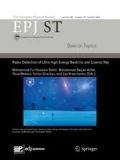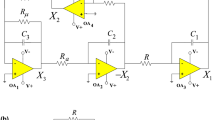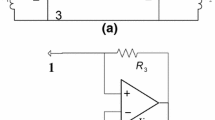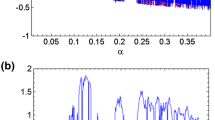Abstract
We investigate the dynamics of the well-known Shinriki’s oscillator both in its symmetric and asymmetric modes of operation. Instead of using the classical approximate cubic model of the Shinriki’s oscillator, we propose a close form model by exploiting the Shockley exponential diode equation. The proposed model takes into account the intrinsic characteristics of semiconductor diodes forming the nonlinear part (i.e., the positive conductance). We address the realistic issue of symmetry-breaking by considering different numbers of diodes within the two branches of the positive conductance. The dynamics of the system is investigated by exploiting conventional nonlinear analysis tools such as bifurcation diagrams, phase-space trajectories plots, basins of attractions, and graphs of Lyapunov exponent as well. In the symmetric mode of operation, the system experiences coexisting symmetric attractors, period-doubling route to chaos, and merging crisis. The symmetry breaking analysis yields two asymmetric coexisting bifurcation branches (i.e., asymmetric bi-stability) each of which exhibits its own sequence of bifurcations to chaos when monitoring the main control parameter. In this special mode, the merging process never occurs; instead, one of the bifurcation branches vanishes when decreasing the control parameter beyond a critical value following a crisis event. The theoretical results are validated by carrying out laboratory experimental studies of the physical circuit.











Similar content being viewed by others
Data Availability Statement
My manuscript has no associated data or the data will not be deposited.
References
L. Pivka, C.W. Wu, A. Huang, Chua’s oscillator: a compendium of chaotic phenomena. J. Franklin Inst. 331B(6), 705–741 (1994)
H.B. Fotsin, P. Woafo, Adaptive synchronization of a modified and uncertain chaotic Van der Pol-Duffing oscillator based on parameter identification. Chaos Solitons Fractals 24, 1363–1371 (2005)
M. Shinriki, M. Yamato, S. Mori, Multimode oscillations in a modified van der Pol oscillator containing a positive nonlinear conductance. Proc. IEEE 69, 394–395 (1981)
E. Freire, L.G. Franquelo, J. Aracil, Periodicity and chaos in an autonomous electrical system. IEEE Trans. Circ. Syst. Vol. CAS 31(3), 237–247 (1984)
J. Kengne, Z.T. Njitacke, N.A. Nguomkam, M. Fouodji Tsotsop, H.B. Fotsin, Coexistence of multiple attractors and crisis route to chaos in a novel chaotic jerk circuit. Int. J. Bifurc. Chaos 25(4), 1550052 (2015)
J. Kengne, N.A. Nguomkam, Z.T. Njitacke, Antimonotonicity, chaos and multiple attractors in a novel autonomous jerk circuit. Int. J. Bifurc. Chaos 27(4), 1–20 (2017)
J. Kengne, F. Kenmogne, On the modeling and nonlinear dynamics of autonomous Silva–Young type chaotic oscillators with flat power spectrum. Chaos 24, 043134 (2014)
C. Kahllert, The effects of symmetry breaking in Chua’s circuit and related piecewise-linear dynamical systems. Int. J. Bifurc. Chaos 3(4), 963–979 (1993)
S.K. Dana, S. Chakraborty, G. Ananthakrishna, Homoclinic bifurcation in Chua’s circuit. Pramana J. Phys. 64(3), 44344 (2005)
H. Cao, J.M. Seoane, M.A.F. Sanjuan, Symmetry-breaking analysis for the general Helmholz–Duffing oscillator. Chaos Solitons Fractals 34, 197–212 (2007)
P. Zhou, H. Cao, The effects of symmetry breaking on the parameterically excited pendulum. Chaos Solitons Fractals 38, 590–597 (2007)
A. Sofroniou, S.R. Bishop, Breaking the symmetry of the parametrically excited pendulum. Chaos Solitons Fractals 28, 673–81 (2006)
S.R. Bishop, A. Sofroniou, P. Shi, Symmetry-breaking in the response of the parameterically excited pendulum model. Chaos Solitons Fractals 25(2), 27–264 (2005)
R. Rynio, A. Okninski, Symmetry breaking and Fractal dependence on initial conditions in dynamical systems: Ordinary differential equations of thermal convection. Chaos Solitons Fractals 9(10), 1723–1732 (1998)
M. Henrich, T. Dahms, V. Flunkert, S.W. Teitsworth, E. Scholl, Symmetry breaking transitions in networks of nonlinear circuits elements. New J. Phys. 12, 113030 (2010)
H. Cao, Z. Jing, Chaotic dynamics of Josephson equation driven by constant and ac forcings. Chaos Solitons Fractals 12, 1887–1895 (2001)
J. Kengne, L.K. Kengne, Scenario to chaos and multistability in a modified Coullet system: effects of broken symmetry. J. Dyn. Control Int. (2018). https://doi.org/10.1007/s40435-018-0483-2
M. Hua, S. Yang, Q. Xu, M. Chen, H. Wu, B. Bao, Forward and reverse asymmetric memristor-based jerk circuits. AEU-Int. J. Electron. Commun. 20, 153294 (2020)
J. Kengne, Z.T. Njitacke, T.V. Kamdoum, N.A. Nguomkam, Periodicity chaos and multiple attractors in a memristor-based Shinriki’s oscillator. Chaos 25(10), 103126 (2015)
W. Liu, Y. Guo, M. Lu, C. Liu, Chaos attractor compressing and expanding in Chua circuit driven by a direct current voltage. In: Proceedings of the international conference on information science and engineering, pp 446–450 (2010). https://doi.org/10.1109/ISIE.2010.105
M.P. Hanias, G. Giannaris, A.R. Spyridakis, Time series analysis in chaotic diode resonator circuit. Chaos Solitons Fractals 27, 569 (2006)
D.W. Sukov, M.E. Bleich, J. Gauthier, J.E.S. Socolar, Controlling chaos in a fast diode resonator using extended time-delay auto-synchronization: Experimental observations and theoretical analysis. Chaos 7(4), 560–576 (1997)
H. Wu, Y. Ye, M. Chen, Q. Xu, B. Bao, Extremely slow passages in low-pass filter-based memristive oscillator. Nonlinear Dyn. 97(4), 2339–2353 (2019)
B.C. Bao, P.Y. Wu, H. Bao, Q. Xu, M. Chen, Numerical and experimental confirmations of quasi-periodic behavior and chaotic bursting in third-order autonomous memristive oscillator. Chaos Solitons Fractals 106, 161–170 (2018)
S.H. Strogatz, Nonlinear dynamics and chaos (Addison-Wesley, Reading, 1994)
X. Jiang, X. Chen, T. Huang, H. Yan, Bifurcation and control for a predator-prey system with two delays. Express Briefs, IEEE Transactions on Circuits and Systems II (2020)
A.H. Nayfeh, B. Balachandran, Applied nonlinear dynamics: analytical, computational and experimental methods (Wiley, New York, 1995)
Y.A. Kuznetsov, Elements of applied bifurcation theory (Springer, New York, 1995)
X. Jiang, X. Chen, M. Chi, J. Chen, On Hopf bifurcation and control for a delay systems. Appl. Math. Comput. 370, 124906 (2020)
X.W. Jiang, X.S. Zhan, Z.H. Guan, X.H. Zhang, L. Yu, Neimark–Sacker bifurcation analysis on a numerical discretization of Gause-type predator-prey model with delay. J. Franklin Inst. 352(1), 1–15 (2015)
N.V. Kuznetsov, G.A. Leonov, M.V. Yuldashev, R.V. Yuldashev, Hidden attractors in dynamical models of phase-locked loop circuits: limitations of simulation in MATLAB and SPICE. Commun. Nonlinear Sci. Numer. Simul. 51, 39–49 (2017)
G. Leonov, N. Kuznetsov, V. Vagaitsev, Hidden attractor in smooth Chua systems. Phys. D 241(18), 1482–1486 (2012)
G.A. Leonov, N.V. Kuznetsov, T.N. Mokaev, Homoclinic orbits, and self-excited and hidden attractors in a Lorenz-like system describing convective fluid motion. Eur. Phys. J. Spec. Top. 224, 1421–1458 (2015)
A. Jafari, E. Mliki, A. Akgul, V.T. Pham, S.T. Kingni, X. Wang, S. Jafari, Chameleon: the most hidden chaotic flow. Nonlinear Dyn. (2017). https://doi.org/10.1007/s11071-017-3378-4
S. Jafari, J.C. Sportt, F. Nazarimehr, Recent new examples of hidden attractors. Eur. Phys. J. Spec. Top 224, 1469–1476 (2015)
A. Wolf, J.B. Swift, H.L. Swinney, J.A. Wastano, Determining Lyapunov exponents from time series. Phys. D 16, 285–317 (1985)
Y.F. Wang, S.T. Qiao, J.G. Jiang, Simulation of chaos in asymmetric nonlinear Chua’s circuit. Shanghai Jiaotong Univ. (Sci) 13(4), 453–456 (2008)
J.J. Healey, D.S. Broomhead, K.A. Cliffe, R. Jones, T. Mulin, The origin of chaos in a modified Van der Pol oscillator. Phys. D 4, 322–339 (1991)
I. Makoto, Synthesis of electronic circuits for simulating nonlinear dynamics. Int. J. Bifurc. Chaos 11, 605–653 (2001)
Acknowledgements
All authors would like to thanks the anonymous reviewers for their constructive comments, critics, and suggestions that helped to improve the content of the present paper.
Author information
Authors and Affiliations
Contributions
All authors have contributed equally for the preparation of the manuscript.
Corresponding author
Rights and permissions
About this article
Cite this article
Kengne, L.K., Kengne, R., Njitacke, Z.T. et al. Effects of symmetry-breaking on the dynamics of the Shinriki’s oscillator. Eur. Phys. J. Spec. Top. 230, 1813–1827 (2021). https://doi.org/10.1140/epjs/s11734-021-00130-z
Received:
Accepted:
Published:
Issue Date:
DOI: https://doi.org/10.1140/epjs/s11734-021-00130-z




